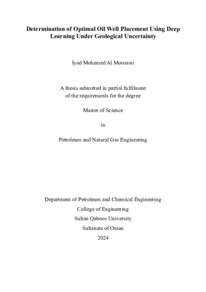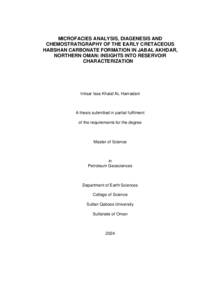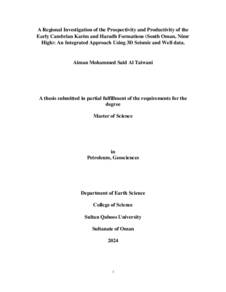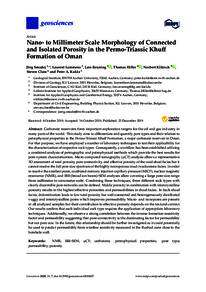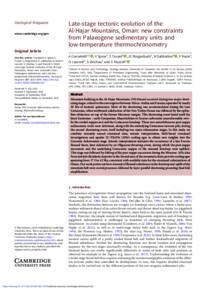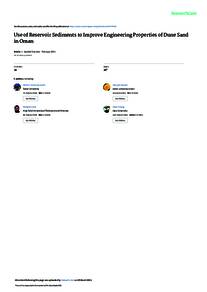Document
Determination of optimal oil well placement using deep learning under geological uncertainty.
Source
Master's thesis
Other titles
تحديد موقع الآبار النفطية الأمثل باستخدام التعلم العميق في ظل عدم اليقين الجيولوجي
Country
Oman
City
Muscat
Publisher
Sultan Qaboos University
Gregorian
2024
Language
English
Subject
Thesis Type
Master's thesis
English abstract
Finding the optimal well placement scenario under geological uncertainty is a challenging task
due to its expensive computational costs. A viable solution is introduced in this study, where a
deep learning multi-input artificial neural network with convolutional layers and fully
connected layers was integrated to build a proxy model that partially substitutes a full physics
reservoir simulator to find the optimal well locations in a one-year field development plan. The
plan consisted of installing an injection and a production well for two periods in a reservoir
exhibiting permeability uncertainty. The methodology started with acquiring data from the
synthetic reservoir egg model by running reservoir simulations for two periods of 6 months
each, then a multi-input deep learning neural network-based proxy model was built to estimate
the potential cumulative oil production at different well locations, and finally, Particle Swarm
Optimization algorithm was coupled with the proxy model to search for the optimal well
locations for each period. The neural network model was trained to input an image of the
permeability realization and a vector of well locations to output cumulative oil production in
𝑠𝑚3
. The data size for the first period was 7500 and 4000 for the second period. Both datasets
were split into 60% training, 20% validation, and 20% testing. The neural network model
yielded a testing coefficient of determination value of 0.89 and 0.73 for the first and second
period, respectively. Furthermore, it was able to suggest a well placement scenario that yielded
a cumulative oil production value that is 96% of the optimal value obtained from conventional
methods for both periods. The proposed solution also dramatically reduced the computational
time, as it required only 25.3% of the time it would take using reservoir simulators for the first
period and only 14.6% for the second period. Thus, the coupling of a deep learning proxy model with particle swarm optimization was found to be reliable for making effective decisions
regarding field development plans under geological uncertainty.
Arabic abstract
يجاد الخطة الامثل لمواقع آبار النفط في ظل عدم اليقين الجيولوجي هي مهمة تشكل تحدياً كبيراً نظراً لطول وقتها الحسابي. في هذا البحث، تم تقديم حلا قابلا للتطبيق حيث تم دمج شبكة عصبية متعددة المدخالت تحتوي على شبكات عصبية تلافيفة وشبكات عصبية اصطناعية لتكوين نموذج ُمختصر يعوض إلى حد كبير عن محاكي خزان الحقل النفطي في عملية تحديد مواقع الابار المثلى في خطة تطويرية لمدة عام واحد. تتألف الخطة التطويرية من حفر بئر حقن و بئر إنتاج في كل ستة اشهر لمدة عام واحد في ظل وجود عدم اليقين الجيولوجي للخزان النفطي. بدأت طريقة البحث بالحصول على البيانات من نموذج اصطناعي لخزان نفط عن طريق محاكاة الخزان لمواقع مختلفة لبئري الحقن والانتاج لفترتين مدتها ستة اشهر. ثم تم تصميم النموذج المصغرعن طريق تدريب شبكة عصبية اصطناعية متعددة المدخلات لتقدير الانتاج النفطي التراكمي المحتمل في مواقع بئرية مختلفة وأخيرا "تحسين تجميع الجزيئات" Swarm Particle (ً المحتمل في مواقع بئرية مختلف تم ربط خوارزمية (Optimization مع النموذج ال ُمطور للبحث عن الموقع الامثل لآلبار لكل من الفترتين. تم تدريب الشبكات العصبية الاصطناعية عن طريق إدخال صور النفاذية للخزان النفطي مع موقع بئر الانتاج و موقع بئر الحقن لتقدير الانتاج النفطي التراكمي في المواقع المدخلة. تم تجميع قاعدة بيانات تحتوي على عدد ٧٥٠٠ من البيانات للفترة الاولى و ٤٠٠٠ للفترة الثانية. ثم تم تقسيم هذي البيانات إلى ٪٦٠ مجموعة بيانات تدريبية و ٪٢٠ تحققية و ٪٢٠ اختبارية. أسفر النموذج المصغر ال ُمعتِمد على شبكات التعلم العميق على قيمة اختبار معامل التحديد تبلغ ٠.٨٩ للفترة الاولى و ٠.٧٣ للفترة الثانية. عالوة على ذلك، كان قاد ًرا على اقتراح خطة تطويرية احتوت على موقع لبئر حقن و بئر انتاج أدت إلى انتاج نفطي تراكمي بدقة ٪٩٦ مقارنة بالقيمة الامثل المأخوذة من الطرق التقليدية لك ٍل من الفترتين. كما خفض الحل المقترح بشكل كبير الوقت الحسابي، حيث تطلب فقط ٪٢٥.٣ من الوقت الذي تستغرقه الطرق التقليدية باستخدام محاكي خزان النفط للفترة الاولى و وتطلب فقط ٪١٤.٣ من الوقت لتحديد المواقع الامثل للفترة الثانية من الخطة التطويرية. بالتالي، ُوجد ان ربط النموذج المصغر عن طريق التعلم العميق المقترح مع خوارزمية تحسين تجميع الجزيئات هو حل فعال لإتخاذ قرارات فعالة بشأن خطط تطوير الحقول النفطية في ظل عدم اليقين الجيولوجي.
Category
Theses and Dissertations

